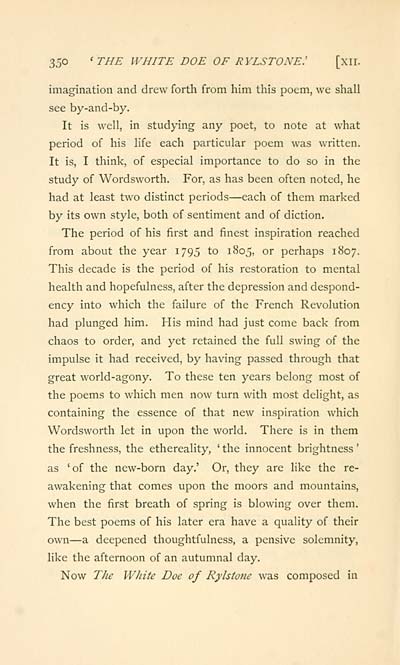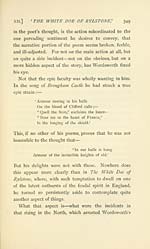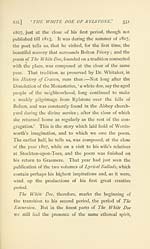Ossian Collection > Aspects of poetry
(366)
Download files
Complete book:
Individual page:
Thumbnail gallery: Grid view | List view

350 ' THE WHITE DOE OF RYLSTONE: [xil.
imagination and drew forth from him this poem, we shall
see by-and-by.
It is well, in studying any poet, to note at what
period of his hfe each particular poem was written.
It is, I think, of especial importance to do so in the
study of Wordsworth. For, as has been often noted, he
had at least two distinct periods — each of them marked
by its own style, both of sentiment and of diction.
The period of his first and finest inspiration reached
from about the year 1795 to 1805, or perhaps 1807.
This decade is the period of his restoration to mental
health and hopefulness, after the depression and despond-
ency into which the failure of the French Revolution
had plunged him. His mind had just come back from
chaos to order, and yet retained the full swing of the
impulse it had received, by having passed through that
great world-agony. To these ten years belong most of
the poems to which men now turn with most delight, as
containing the essence of that new inspiration which
Wordsworth let in upon the world. There is in them
the freshness, the ethereality, ' the innocent brightness '
as 'of the new-born day.' Or, they are like the re-
awakening that comes upon the moors and mountains,
when the first breath of spring is blowing over them.
The best poems of his later era have a quality of their
own — a deepened thoughtfulness, a pensive solemnity,
like the afternoon of an autumnal day.
Now The White Doe of Rylstone was composed in
imagination and drew forth from him this poem, we shall
see by-and-by.
It is well, in studying any poet, to note at what
period of his hfe each particular poem was written.
It is, I think, of especial importance to do so in the
study of Wordsworth. For, as has been often noted, he
had at least two distinct periods — each of them marked
by its own style, both of sentiment and of diction.
The period of his first and finest inspiration reached
from about the year 1795 to 1805, or perhaps 1807.
This decade is the period of his restoration to mental
health and hopefulness, after the depression and despond-
ency into which the failure of the French Revolution
had plunged him. His mind had just come back from
chaos to order, and yet retained the full swing of the
impulse it had received, by having passed through that
great world-agony. To these ten years belong most of
the poems to which men now turn with most delight, as
containing the essence of that new inspiration which
Wordsworth let in upon the world. There is in them
the freshness, the ethereality, ' the innocent brightness '
as 'of the new-born day.' Or, they are like the re-
awakening that comes upon the moors and mountains,
when the first breath of spring is blowing over them.
The best poems of his later era have a quality of their
own — a deepened thoughtfulness, a pensive solemnity,
like the afternoon of an autumnal day.
Now The White Doe of Rylstone was composed in
Set display mode to: Large image | Transcription
Images and transcriptions on this page, including medium image downloads, may be used under the Creative Commons Attribution 4.0 International Licence unless otherwise stated. ![]()
| Early Gaelic Book Collections > Ossian Collection > Aspects of poetry > (366) |
|---|
| Permanent URL | https://digital.nls.uk/78389664 |
|---|
| Description | Selected books from the Ossian Collection of 327 volumes, originally assembled by J. Norman Methven of Perth. Different editions and translations of James MacPherson's epic poem 'Ossian', some with a map of the 'Kingdom of Connor'. Also secondary material relating to Ossianic poetry and the Ossian controversy. |
|---|
| Description | Selected items from five 'Special and Named Printed Collections'. Includes books in Gaelic and other Celtic languages, works about the Gaels, their languages, literature, culture and history. |
|---|

